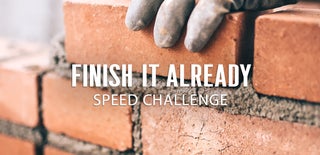Introduction: Modernized Cabinet
A couple months ago my family was redoing an older trailer home to make it look a little more modern while simultaneously doing major construction to our house. That alone was biting off a bit more than we could chew. But, there was a specific spot in the trailer house that needed a cabinet but nothing online or in stores seemed to fit the size we needed.
We realized we had an old bookshelf/cabinet we have been holding on to for a long time that was the exact dimensions we needed. Based on it's look, it was probably about a thousand years old so it needed a little bit of a face lift before adding it to our modernized home.
I started off really excited to transform this project into something modern but like any project it seems a lot simpler than it really is.
It took me a day to buy everything, take it apart, sand it, and paint it so by the time the day was over, I set it to the side to "finish tomorrow"….2 months later it had accumulated some of our pantry items from our house because our kitchen was getting redone. We have already sold the trailer home by now but this challenge has been the perfect opportunity to actually finish the project I started and use it to store some things that need a home.
Supplies
Screw driver (or electric screwdriver)
Electric Sander
1 can metallic spray paint of choice (I used oil rubbed bronze)
7-10 cans spray paint of choice (I used mint)
Cardboard box
1 small can Chalkboard paint
Pliers
1 roll of contact paper of choice (I used Marble)
Scissors
Nail & hammer, nail gun, or staple gun
1 small roll of jute twine
Hot glue gun with hot glue
Plastic knife
Step 1: Previously
- I removed all the screws, hinges, and doors from the bookshelf
- Expert tip: label or take pictures of the hinges and screws before you take them off so you remember where they came from
- With an electric sander, I sanded the surface of the bookshelf and all the doors so the paint would stick and because the grain was really strong in the wood.
- I laid the doors and bookshelf outside on a sheet that could get painted
- Using Rust-oleum's mint colored spray paint, I painted every visible surface until it was covered to my liking. It took me about 8 cans to get the color I wanted with the size of the bookshelf which was about 3 coats. (letting it dry between each coat)
- Lastly, I let it dry (for about 2 months, although it really only need about 2 hours:)
Step 2: Hinges and Screws
- Lay the hinges and parts on a cardboard box outside and poke the screws into it
- Spray them with a metallic spray of your choice (I used Rust-oleum's oil rubbed bronze, pictured above)
- Let them dry in the sun for at least an hour before turning the hinges and parts over to spray the other side until each piece is entirely covered.
- Let dry 1-2 more hours
Step 3: Chalkboard Door
In the middle of my bookshelf there is a pull-down door.
- I painted the center with a couple layers of chalkboard paint and let it dry.
Step 4: Backdrop
- Take out the nails from the back of the shelf that are holding the back wooden board on.
- Remove the back board and cover with contact paper of your choice (I used marble), making sure the over laps are where the shelves would go so they cover the lines.
- My bookshelf also had doors with little indented squares so I covered those with contact paper too.
- Behind the bottom doors there was also a back piece that wasn't attached to the rest of the back so I covered that with contact paper also.
Step 5: Assembly
- Once all the pieces were dry, my step-dad helped me attach the backboard back on with a nail gun (you could also use a staple gun or do it manually)
- Next I took all the hinges, screws, and doors and attached them back on with an electric screwdriver but again, you could also do this manually.
Step 6: Final Touches
On the top two shelves I used a roll of jute twine to decorate the back of the cabinet. This added a cute, rustic touch to the cabinet and also a cool way to hang pictures or notes with clothes pins.
First I put a dot of hot glue anywhere around the edge of the shelf then I used a plastic knife to poke the twine onto the hot glue and into the crease as much as I could until it dried. I did this first with the end of the twine then I randomly strung it across the back with this same process until I liked the way it looked.
....And your done!!!!

Participated in the
Finish It Already Speed Challenge











